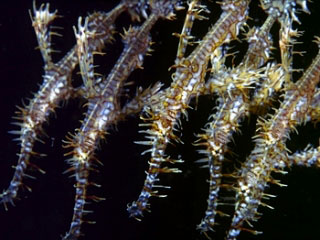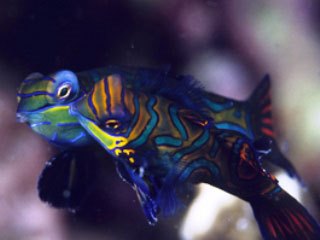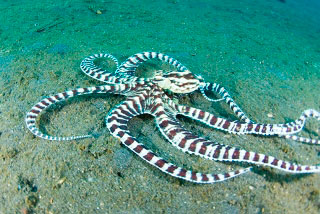"Over 19 years making dreams come true for divers... just like you"
Contact us now at ask@dive-the-world.com
Macro Diving
Welcome to the Miniature and Miraculous Marine World
'Macro' means large in scale and is a term that is used in relation to tiny creatures because photographers use macro lenses to allow them to take big, close up pictures of the minuscule. The term 'macro diving' is now widely used in the greater diving community for dives that do not focus on the big stuff.

Keen macro divers are not blown away by a manta or a shark sweeping past, and big schools of fish don't tend to fill them with a sense of awe. They just want to get up close with those creatures of lesser stature, but no less fascination, such as pygmy seahorses, pipefish and commensal shrimps to name but a few. The big stuff only holds the ultimate fascination for a certain while, at least for most people. Often divers move from an almost exclusive interest in the big and the bold, to interest in the minute and mysterious, as they gain more experience. But some divers take this process to nature's end, where they actively seek out and dive locations that are the exclusive domain of macro critters.
2 divers can be finning around a beautiful colourful pinnacle and emerge on to the dive boat having had 2 totally different experiences. One may be chatting about the sharks and schools of fish he saw as he was hovering, staring into the blue. Perhaps a manta or a turtle may have also put in an appearance and he is satisfied with the creature list in his dive log.
However, the other diver saw none of these things. He was not staring into the blue, but poking his head around the nooks and crannies of the pinnacle. He may have seen (and probably tried to photograph) a sea whip with 2 little gobies scuttling along its edge, a crinoid which was home to both a crinoid shrimp and a clingfish, a couple of banded pipefish in a quiet recess in the rock and a mantis shrimp scurrying over the sea bed. Diver number 2 had a totally different experience because he was interested in macro subjects.
Photography with a macro lens can be done in a variety of different environments since there are always small things to be discovered, whether on the reef, on an encrusted wreck, or around the silty underside of a pier, or a black sand bay. The small stuff in marine environments like these have been the subject of interest among certain divers for many years and from this a whole new branch of recreational diving has developed - macro diving - whose enthusiasts eschew the reef in favour of the more obscure and less visited marine environments.
History
Macro diving was most probably 'invented' when the first diver decided only to focus on the little curiosities that exist in the marine environment. Its name was likely to have been coined when the first underwater photographer decided to take his macro lens down with him to capture images of the minuscule.
Conditions
There are critters that require macro lenses in almost every marine environment except the open ocean. Reefs, wrecks and anywhere that there is some substrate, nutrients and potential shelter for small creatures, are places where the small and incredible may lurk. However the pursuit of macro really means going on dives with only the small stuff in mind, often in places where you won't find the bigger marine creatures.
Conditions tend to be shallow water, close to shore in areas where coral, if present, is not particularly vibrant (indeed it may be dead), in seagrass beds, or, if we are talking about the more specific 'muck diving', in black sand or silty conditions. In short, diving in environments where you are less likely to see anything bigger than an octopus and an array of weird and wonderful bottom-dwelling creatures. Indeed, where smaller creatures are more numerous, there are also likely to be juveniles of larger species that will live in this environment until they grow to a large enough size to venture further afield and mix with the bigger boys.
Habitat

Genuine macro habitats tend to be in shallow areas free from the dangers posed by larger reef predators, as this not only allows juveniles to develop, but also allows other creatures to dominate the food chain. Areas must also be protected from strong currents, swells, and surf, as these would destroy the delicate balance and structure of the environment. Small bays, lagoons and coves, are often suitable as macro dive sites for this reason.
Many of the macro habitats have specific and often unique characteristics that lend themselves well to natural selection and the survival of the fittest. Creatures that live and flourish in these conditions have often had the opportunity to adapt unusual features over millions of years, in order to survive there. They may have bizarre colouration, unique camouflage, obscure appendages, or incredible strike and attack techniques. There are a number of different environments where these conditions can be said to exist:
Shallow sandy reefs: In areas such as Mabul Island and Kapalai in Malaysia, there are shallow reefs of mixed health (some vibrant, some dead) and the visibility is normally quite limited. In these shallows there are much fewer large predators than can be found at nearby Sipadan, so you can expect to see many juveniles spending the early stages of their lives in this more secure environment. You may spot juvenile sweetlips, lionfish, scorpionfish and cuttlefish as well as ribbon eels, crocodilefish and frogfish to name a few.
Sea grass beds and mangrove forests: It is a common sight to see divers trawling through shallow water where the environment is a favourite for seahorses who will often attach to a stalk of seagrass with their prehensile tails. Areas near to mangroves also often have silty seabeds and are another rich hunting ground for divers looking for juvenile reef fish and other smaller oddities. Various species of pipefish will also call this home. Ceningan Island at Nusa Lembongan has some mangroves that are worth exploring.
Underneath jetties or other structures: Jetties by their nature tend to be built over shallows, and the struts and supports of the jetty provide areas of shade and shelter for those creatures that favour living in shallow conditions far from big predators. Jetties also tend to see many objects dropped into the water such as construction materials, cans, bottles and such like, which creates a unique underwater habitat. These factors can combine to provide ideal conditions for small and juvenile creatures to flourish in relative safety.
The dive site below the Seaventures Dive Platform in Mabul is a good example of this. Below this converted oil rig, and among the rubble that clutters the sea bed, is a richness of small creatures that has made this one of the best macro dives in the area. The bay wall of Banda Neira in the Banda Islands is also another good example. On dusk dives here you can see mandarinfish, bobtail squid and all manners of crustaceans.
Black sand/silty conditions: The specialist domain of muck diving is in places which have this kind of substrate, and it's where you are likely to spot even more bizarre creatures and often in greater numbers. Creatures that seem to favour these conditions include mimic octopus, stargazers, flounders, various species of frogfish and seahorses. There are several areas that provide this environment, but perhaps the most famous is the Lembeh Strait in Indonesia.
Creatures that Inhabit

The list of creatures that are much more common in macro diving conditions reads like a 'who's who' of the small and fascinating.
Seahorses and their pygmy cousins tend to be much more numerous in these conditions and have long been a favourite with underwater cameramen. Frogfish appear on normal coral reefs too but your chances of seeing them are greatly increased if you seek out areas known for their macro life, where you may see painted, giant, clown and various other species of this interesting critter. Octopus too can be found on the reef if you are in the right place at the right time, but in genuine macro areas, particularly where muck conditions exist, you can see a whole host of different species including blue-ringed octopus, mimic octopus, long-armed octopus, wonderpus and many others. Flounders and blue spotted stingrays are also more common in these condition,s as are pipefish, mandarinfish, mantis shrimp, scorpionfish, flambuoyant cuttlefish, jawfish, stargazers, pegasus and flying gurnards.
Specialised Macro Dive Equipment
Since many of your friends back home are not likely to believe you when you begin describing the creatures that you saw, it's a good idea to invest in a good underwater camera. You won't be needing a wide angle lens, but high quality macro lenses, a 'fish eye' lens, and strong lights are all pretty much essential.
Even if you're not taking pictures, a good torch can help you shine light into crannies and expose camouflaged creatures. And once you've found the creatures, many divers find that a magnifying lens is useful for observing their details (here, we're talking about the likes of squat lobsters, sea lice and some of the small shrimps and crabs).
Since many of these animals are highly poisonous, many divers find a reef tickle stick useful to avoid contact, and some wear gloves. Nitrox is also useful to have as macro diving tends to be very slow going and requires substantial bottom time to cover the reef satisfactorily.
Our Macro Scuba Destinations
If you're interested to test out the attractions for yourself, then why not visit one of these superb macro diving destinations:
Indonesia
Malaysia
| • Kapalai | • Lankayan |
| • Mabul Island |
CUSTOMER TESTIMONIALS OF DIVE THE WORLD
... It was very easy for us to find the right information, good website. Booking is very easy and we like to pay through website system. It is a nice opportunity to pay using link received from sales staff ... -- Yulia Lobanova, Russia. [More customer reviews]



